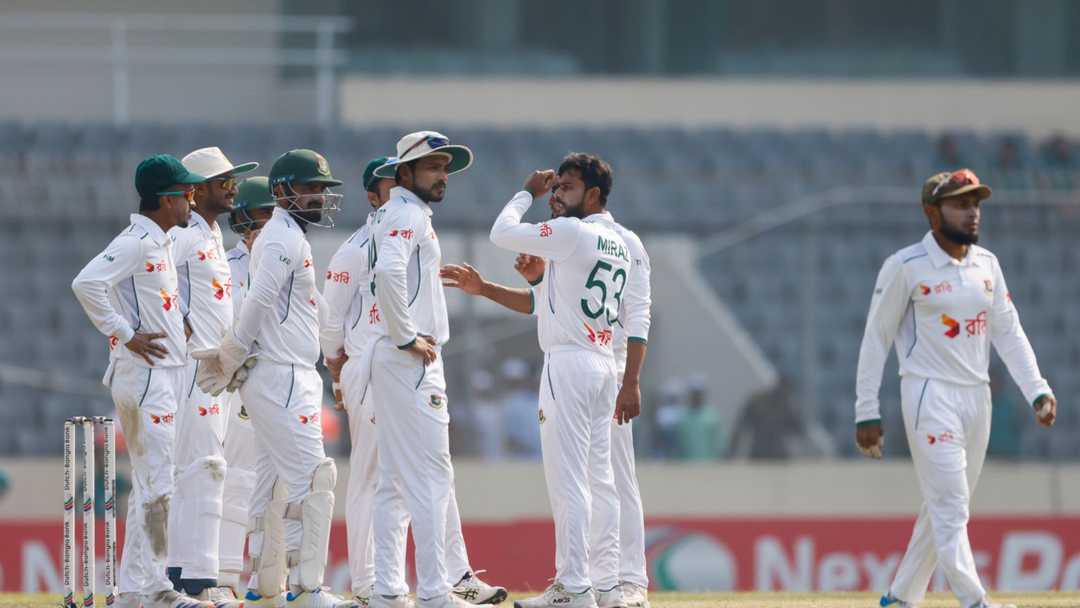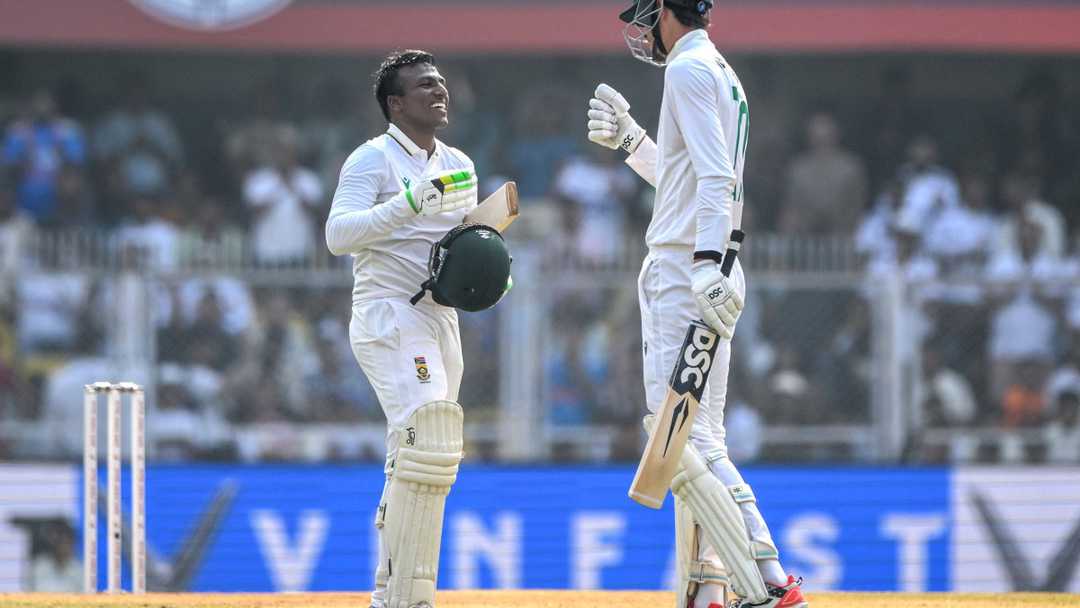
Inside the mind of Smaran Ravichandran
Smaran Ravichandran's rise through Karnataka cricket has not been sudden. At just 22, his progress has been steady, layered, and grounded in habits formed long before he entered first-class cricket. This Ranji Trophy season, he has already notched two double hundreds, building on the one he scored in his debut season earlier this year — a progression that feels less like a breakout and more like the natural continuation of a structure that has been in place for years.
Smaran's consistency across formats over the last two seasons — be it the Vijay Hazare Trophy, the Maharaja Trophy, the Ranji Trophy, or the Duleep Trophy — points to a player who had been quietly building towards this phase well before wider recognition arrived. Since his first-class debut in October 2024, he has amassed nearly 1,200 runs in 13 matches, including four hundreds, three of them double centuries. In his maiden Vijay Hazare Trophy season, he scored 433 runs, with two centuries and two fifties, including a three-figure innings in Karnataka's title-winning game.
His returns have steadily improved with each competition cycle, reflecting not just form but a refinement of method: a clearer tempo in white-ball cricket, sustained periods of control in red-ball games, and the ability to adapt to varied team roles across formats.
"I think the main shift was just in the mindset," said Smaran in a chat with Cricbuzz. "I think I always had the game to score big runs. So, the shift in mindset was just to grind it out, out there in the middle. At the elite level, you don't get your runs very easily. You have to work really hard for it.
"And I think playing out those sessions and playing out those tough phases of play during the game was something that was always running in my mind. The main focus that was running in my mind was to get Karnataka to a very solid platform at the end of the day, or at the end of the innings, so that we can really push for an outright victory. That just made things very easy for me to plan out my innings."
That clarity in preparation began during school, when his academic performance was in the top bracket even as he played Under-16 and Under-19 state cricket. Balancing a demanding ICSE curriculum while representing Karnataka at two age-group levels forced him to engage a level of discipline that few young athletes experience. His family's academic background added its own expectations, and the early tension between academics and cricket shaped a seriousness that continues to define him.
"When he was in 10th standard, even though he played Under-16 and Under-19, he still got 92% in ICSE boards. His parents come from an academic background, so they were very concerned," recalls Syed Zabiulla, Smaran's childhood coach. "His father was supportive, but his mother was silent and worried. I told them, 'If you take this path, don't expect me to support academics. If things don't go well, I'll be the one blamed.' Whenever he doesn't perform, I still apologise to them for being the reason he chose cricket."
Smaran's journey into professional cricket, though, began almost by chance. "My mom put me there during the summer to just keep me engaged in something because I was a very naughty kid growing up. So, I think the journey just started from there and I never really knew that it would become a professional career of mine. I just started off because I liked the game and just liked playing it. And then, after a point in time, I realised that I'm good at this sport and started playing well.
"There was a point where I represented Karnataka for the first time at the U-14 level, and that was the first Karnataka state camp that I attended. So, I think that was the point I realised that, okay, this is something that I would want to pursue professionally."
A large part of Smaran's evolution has been driven by a match-specific understanding of the game. The training routines he followed as a teenager, particularly in the first division league, were designed around adapting to shifting conditions and phases of play. He learned to think about innings in segments: begin like a Test opener, shift gears like a one-day batter, and finish like a T20 hitter. It was a demanding structure meant to make him comfortable across formats long before he played professionally.
Smaran's coach explains: "Whichever number you are going to bat, first 50 overs, you will play like a Test match. Then 51st over to 80th over, you will bat like a one-day match. Last 10 overs, you are going to bat like T20. The day when you finish this, I will give you the approval that you are a three-format player. Till then, don't ask me if you are a three-format player. The world might agree, but I am not going to agree that you are a three-format player. See, basically this is in process. This method is in process and I believe that process is everything."
That method was reinforced through Karnataka's two-day league games, where tempo, patience, and field manipulation could change drastically over short periods. These routines have surfaced in his domestic performances: the ability to bat long without losing shape, the readiness to accelerate when required, and the awareness of when the game needs stability instead of scoring. Over time, these skills have become second nature rather than forced adjustments.
His growth across formats has been especially visible in the last few seasons. In the Vijay Hazare Trophy, he played critical innings in knockout stages, showing he could manage pressure in limited-overs cricket. In the Maharaja Trophy, he displayed improved power access and tactical T20 clarity. In the Duleep Trophy, he showed he could absorb pressure across sessions. And in the Ranji Trophy, his ability to make big hundreds — and to repeat them — has stood out in a format that reveals technique, temperament, and discipline more than any other.
"I think a lot of credit goes to Syed sir here. Seeing the domestic schedule, we start off with Ranji Trophy and then we head on to Mushtaq Ali and then again we head on to Vijay Hazare. Within a span of a week we again get back to Ranji Trophy. There's not a lot of time where we can adjust between formats," Smaran says.
"During the off season we really worked on it — we used to bat 4 or 5 sessions of red ball and then immediately the next day we used to get into a session of white ball. So that has really helped me in terms of making that switch quick and not taking that extra time of switching between formats. Because usually when you switch formats, two or three innings would have gone by the time you adjust, and then the entire tournament would have passed by. So I think it's very important to make that switch immediately and that is something that I have worked on."
Similar emphasis has been placed on fitness.
"It's a long season, with almost no gaps between games, and you have to make quick switches between red-ball and white-ball formats. During the off-season, a lot of work goes into making yourself strong enough to handle the stress your body goes under. Even during the season, every off-day is for recovery, nutrition, strength, and mobility sessions. A lot of credit goes to Invictus Performance Lab in Bangalore — they've been constantly pushing me to get recovery and strength right."
The time spent with Sunrisers Hyderabad in the IPL has also added an important layer to his understanding of modern T20 batting. Even without extensive game time, being part of an environment with some of the most explosive ball-strikers in the world sharpened the way he's approached T20 batting. Smaran was picked by SRH in the last IPL as a replacement player.
The opportunity came in a way only cricket seems to allow. As Smaran recalls: "It's actually a funny story. I was playing a first division league game in Bangalore. I usually don't use my phone during the game. We were batting during that time and I was in the pavilion, I had my pads on. And then I never knew that I would get a call. Another teammate of mine was using the phone, and then he got a call from one of his friends telling me to pick up the call because SRH is trying to contact me.
"Immediately I opened my phone and got a call saying that I'm the replacement player for Adam Zampa. I couldn't think much at that time because I was focusing on my batting. It was towards the end of the day. I went in to bat after that and I finished on 35 not out or something like that. But after the game, the feeling slowly sunk in that I'm getting to be a part of an IPL team. I was really excited."
That instant leap from domestic league cricket to an IPL dressing room offered lessons that went far beyond technique.
"Our team is filled with one of the most destructive lineups a T20 side can have," says Smaran. "There's so many guys who have been successful at the highest levels of the game. And during the nets, I had a lot of conversations with [Heinrich] Klaasen, with Ishan Kishan, and guys like that. Just in terms of how they conduct their game and what runs through their mind when they're playing a particular bowler. Which bowler to take on, when, and just conversations about batting. And obviously I got some very valuable inputs from all the guys that I had a conversation with.
"I was there for a very short period of time — only for 10-15 days and then I got injured as well. But in the short time I was there, a lot of guys actually (influenced me). Abhishek Sharma had his own way of going about things, Ishan Kishan did, Klaasen did as well. I don't think I can pinpoint anybody. Just seeing them from 10-20 meters distance was a great privilege because just a couple of weeks back I was seeing them on TV. Going out there and just watching them from a small distance was really overwhelming and I was grateful to be a part of that setup."
This season has marked a clear shift in temperament rather than technique. The focus on turning starts into big contributions has been evident in the way he has built innings patiently and avoided early risks. It reflects a deliberate decision to address an old issue — throwing away starts — which he identified ahead of the season. His shot selection has been calmer, the risk-taking more calculated, and the willingness to bat through tough spells stronger than before.
Looking forward, the competition for batting spots — both in Karnataka and beyond — is intense. With bowlers now studying his patterns more closely, the next phase of his development will revolve around expanding his scoring options, refining his strengths, and responding to targeted plans. The analytical landscape of domestic cricket has evolved significantly, making adaptability and continuous improvement essential.
"The competition for lefties, you can't even imagine," says Syed Zabiulla. "All of a sudden, it has increased like anything…I just want him to be grounded, be disciplined, whatever he has done so far. Not to get distracted. And I think if he covers up these areas, the rest he knows. He's a very responsible player. And if he doesn't get distracted, that itself will take him to the next level.
"Yes, the learning is there. People will try to find your weaknesses. Today is an AI era where you'll do a lot of video analysis. And we are ready to face the challenges and come back better. The only thing is to work on the mindset — take your strength to the next level by converting your weaknesses into strength."
Smaran adds: "You're never perfect and there is always something that you need to work on, be it batting or fielding. But now, since you're in the season, you cannot make too many technical changes and you can only make quick switches between formats. I think that is the most important thing."
From first-division leagues to Ranji double hundreds, a mid-season call-up from SRH and even being retained by the same franchise — his rise is deliberate and methodical. As Smaran sums it up: "Every match teaches you something new, and that's what keeps me going."



